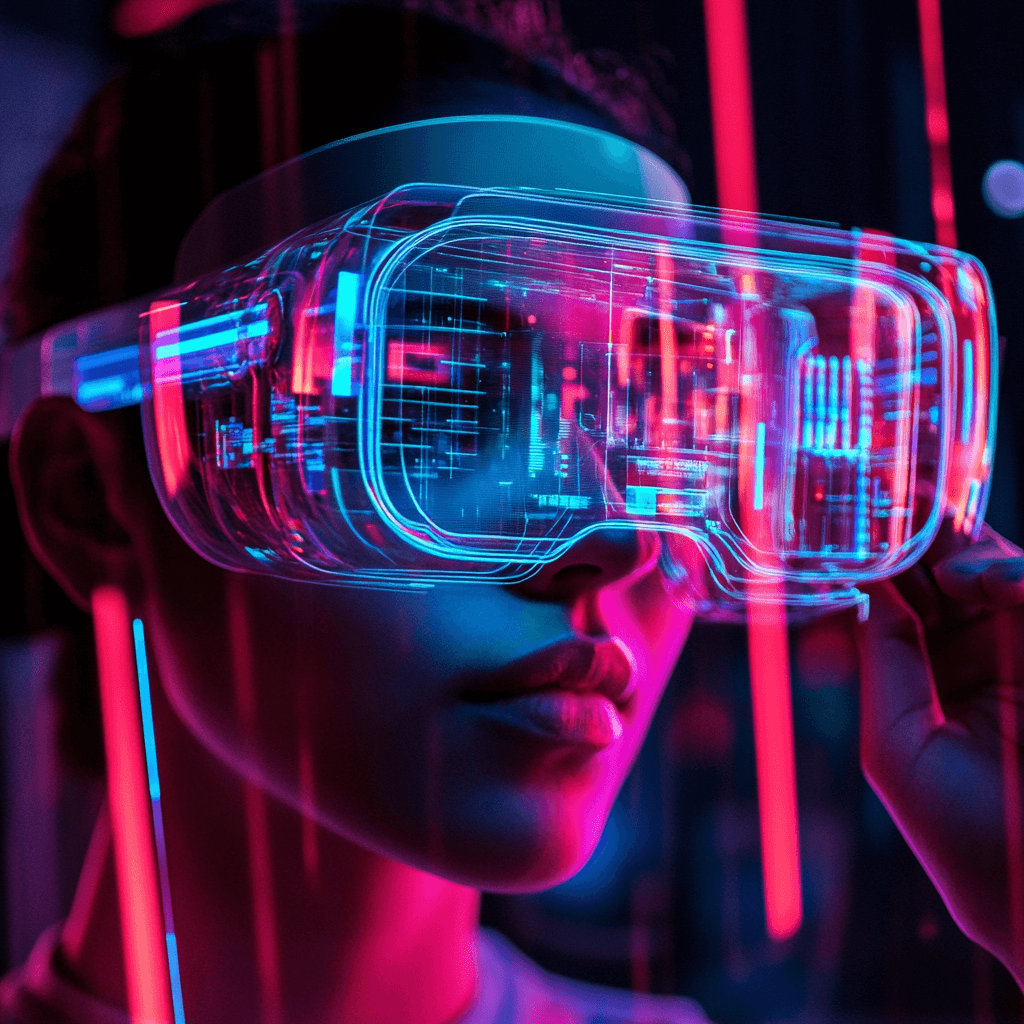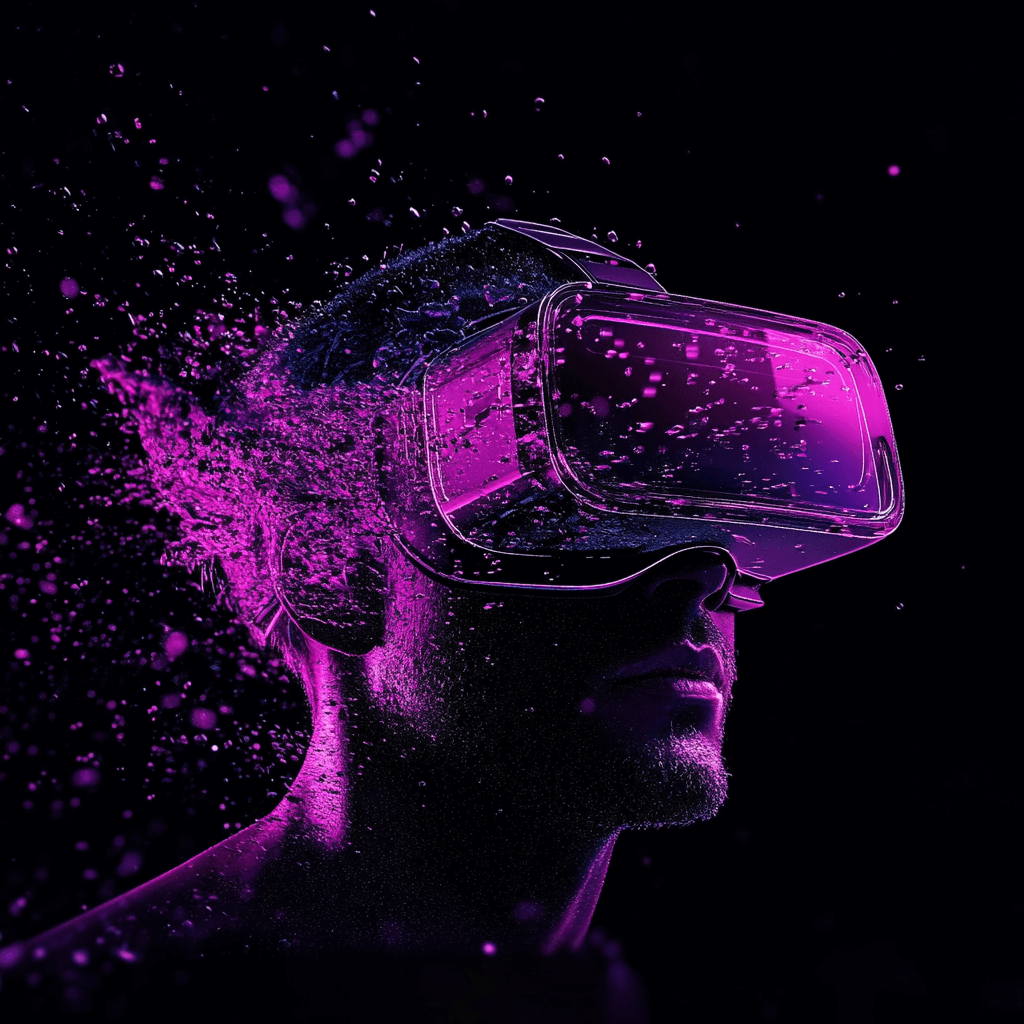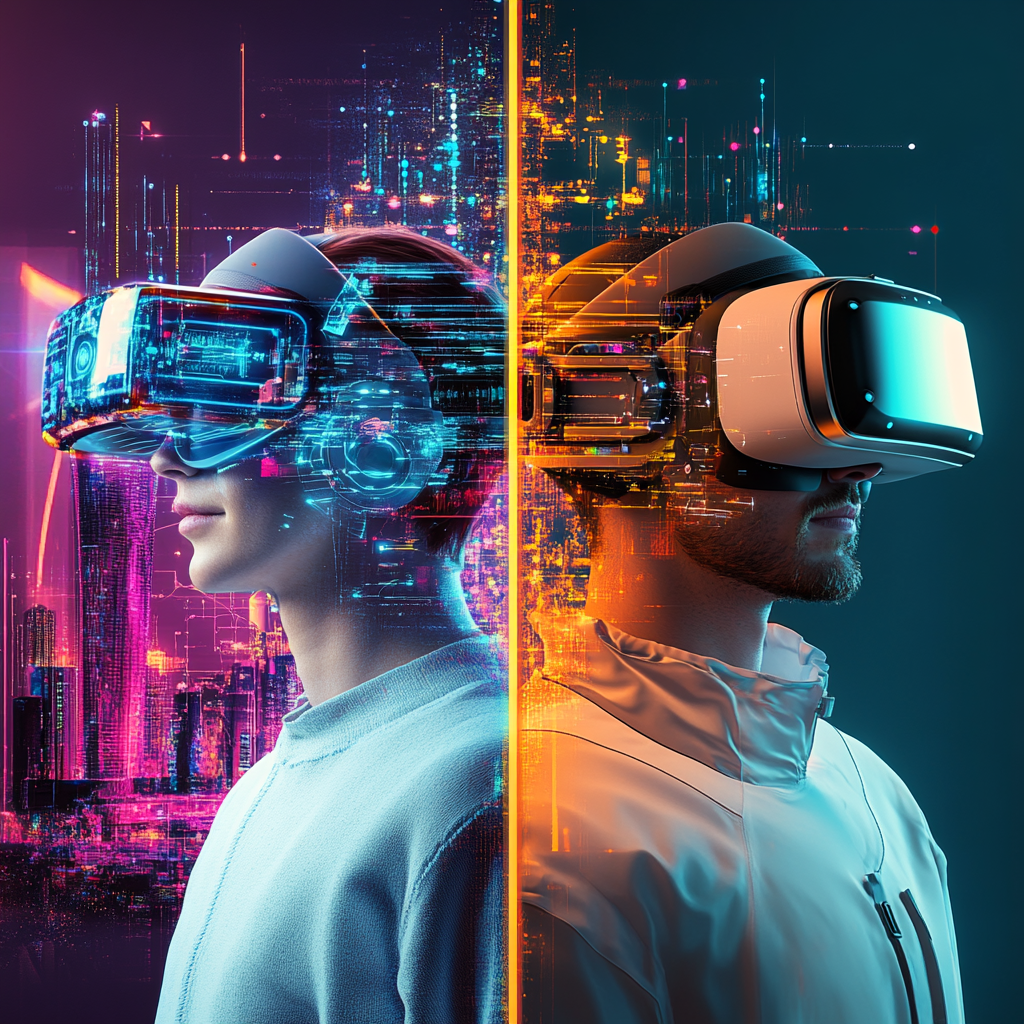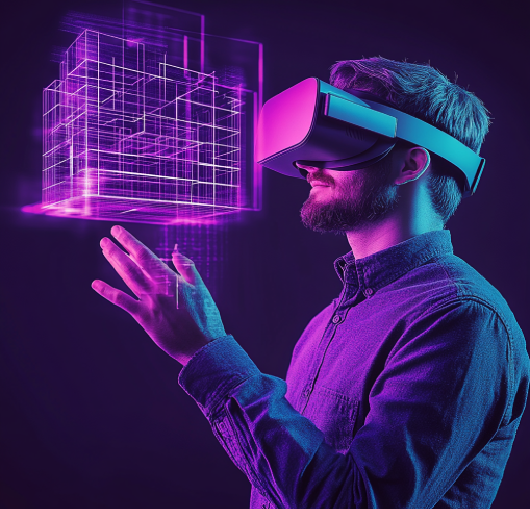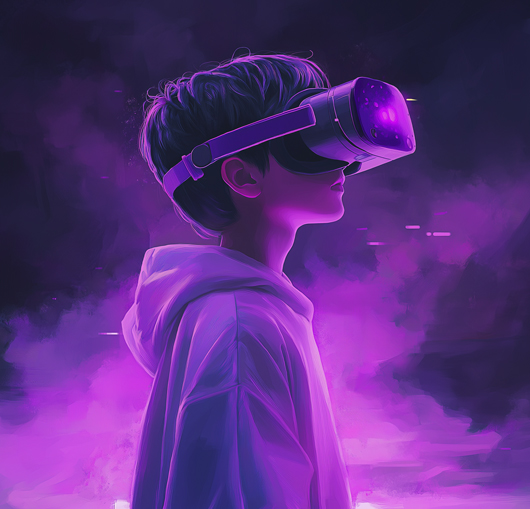Augmented Reality (AR) vs. Virtual Reality (VR)– Key Differences, Applications, and Future Trends
Augmented Reality (AR) and Virtual Reality (VR) are transforming how we interact with digital content to fill the gap between the real and virtual worlds.
AR overlays digital elements onto the real-like ambiance, enhancing real-world experiences, while VR creates a fully immersive digital environment, shutting out the real world.
As industries like gaming, healthcare, education, and retail increasingly adopt these technologies, understanding AR vs VR is more important than ever. According to Maunder (2018) website, the integration of VR and AR in the education market is expected to reach 19.6 billion with an annual growth rate of 16.2% by 2023.
As an artificial intelligence development company, we will explore the key differences, applications, and future trends of Augmented Reality and Virtual Reality in this blog post, shedding light on how they are shaping the future of innovation and user experiences.
What is Augmented Reality (AR)?
Augmented Reality meaning (AR) puts pictures or videos over what you see in the real world, often on your smartphone. This mix of real things and digital images helps you interact and creates new experiences. With AR and computer-generated images (CGI), you can see objects as if they were right there in front of you.
➔ How Does AR Work?
AR – augmented reality through devices like smartphones, tablets, and AR glasses. Cameras and sensors map the surroundings and project digital content in real-time. Advanced AR systems utilize AI and computer vision to seamlessly integrate the physical and digital worlds.
AR Examples
Here are the some of the well-known AR example. Believe it or not – you might have used many of these already as Augmented Reality agencies are incorporating them into every industry. Let’s have a look at these examples.
- Pokémon Go – This Game places virtual Pokémon in real-world locations or your surroundings.
- Snapchat Filters – We all have used snapchat and its filters. In Snapchat filters, you use face-tracking AR effects that add animations to user selfies.
- IKEA Place App – IKEA has an app that allows its users to visualize furniture in their homes before purchasing.
➔ Benefits of AR in Industries
AR- Augment Reality is revolutionizing multiple industries by enhancing their efficiency and customer engagement.
- Retail – The retail industries like clothing, makeup, and furniture are utilizing Augmented Reality for mock-up tests without buying them.
- Healthcare – With the help of Augmented reality, medical Healthcare staff are being trained with medical simulations.
- Education – Learning can be more fun with special apps and books that use augmented reality (AR). These help you see and interact with the lessons in a new way.
With its growing adoption, AR continues to transform how we interact with technology, making digital experiences more engaging and practical.
What is Virtual Reality (VR)?
So, you search for; what is VR? Virtual Reality meaning (VR) is a technology that creates a complete digital world, allowing people to feel like they are in a different place. With VR – Virtual Reality, users can see and interact with 3D objects and environments created by a computer.
This marks a difference from Augmented Reality, which adds digital things to the real world. In VR, the real world is completely replaced by a virtual one, providing an entire experience that feels like a game or a different reality.
➔ How Virtual Reality Works?
To experience Virtual reality (VR), users need to utilize special goggles called head-mounted displays (HMDs) like the Oculus Rift, HTC Vive, and PlayStation VR. These goggles track your head movements so you can see in all directions, creating a full virtual experience. When you add motion controllers, which let you use your hands, and haptic feedback, which gives you touch sensations, along with sounds that come from different places, VR makes you feel like you are really inside another world.
Virtual Reality Examples- You Might Have Stepped On
Some popular VR examples include–
- Oculus Rift & Meta Quest – Next-level VR headsets for immersive gaming and simulations, providing the new worlds of possibility.
- VR Gaming – Games like Beat Saber and Half-Life– Alyx provides you with interactive, immersive experiences.
- Virtual Tours – Real estate platforms using VR to provide 3D property walkthroughs.
➔ Benefits of VR in Industries
VR is revolutionizing multiple industries by enhancing user engagement and training simulations–
- Gaming – Fully immersive experiences with lifelike environments and interactivity.
- Training & Education – VR-based training for pilots, surgeons, and military personnel.
- Real Estate – Virtual property tours allow buyers to explore homes remotely.
With its ability to create immersive digital environments, Virtual Reality continues to reshape entertainment, training, and business operations, unlocking new possibilities for innovation.
Key Take Away: If you are looking to step on a top-tier Augmented Reality agency – enlist Digital Gravity as your trusted partner for interactive experiences.
Key Differences Between AR and VR
As Augmented Reality (AR) and Virtual Reality (VR) continue to revolutionize industries, understanding their differences is crucial. While both technologies enhance digital interactions, they do so in distinct ways.
Let’s explore the difference between augmented reality vs virtual reality by comparing their environments, hardware, user interaction, and applications.
1. Environment– AR Enhances and VR Transforms
The most significant comparison between AR and VR lies in how they engage users with their surroundings.
- AR enhances the real world by overlaying digital elements, allowing users to stay connected to their physical environment.
- VR creates a fully immersive experience, transporting users into a completely virtual space, shutting out the real world entirely.
For example, with AR, you can see digital objects appear in your living room, while VR places you inside a completely different world, such as a virtual game or a training simulation.
2. Hardware– Different Devices for Different Experiences
The hardware requirements for AR and VR differ significantly–
| Feature | Augmented Reality (AR) | Virtual Reality (VR) |
|---|---|---|
|
Devices |
Smartphones, AR glasses (e.g., HoloLens) |
VR headsets (e.g., Oculus Rift, HTC Vive) |
|
Connectivity |
Uses mobile apps and lightweight wearables |
Requires powerful computing and motion sensors |
|
Accessibility |
More accessible with mobile devices |
Requires dedicated hardware for immersive experiences |
AR is more convenient as it runs on devices like smartphones and tablets, while VR demands specialized headsets for complete immersion.
3. User Interaction– Blending Reality vs. Full Immersion
The difference between AR and VR also extends to how users interact with digital elements.
- AR allows interaction with both digital and physical objects, making it useful for real-world applications like virtual try-ons and navigation.
- VR isolates users in a virtual environment, offering immersive gaming, training, and simulation experiences.
For example, Snapchat AR filters let users interact with augmented effects in real time, while VR-based games like Beat Saber immerse players in a completely digital environment.
Applications of AR and VR
Did you know, according to stats, user’s ability to freely explore the AR or VR environment was the most prominent interactive affordance, found in 19% of applications? The rise of Augmented Reality (AR) and Virtual Reality (VR) has transformed industries, improving customer experiences, training methods, and healthcare solutions.
While AR enhances the real world by overlaying digital elements, VR creates fully immersive environments, making them ideal for different use cases. Let’s explore the applications of AR and VR across various sectors.
➔ Augmented Reality (AR) Applications
So, now you might be wondering how individuals and businesses are using Augmented Reality in their daily lives.
1. Retail– Virtual Try-Ons & Interactive Shopping
Retailers are using AR technology to enhance shopping experiences. With virtual try-ons, customers can see how clothes, accessories, and makeup look on them without physically trying them on.
- Beauty brands like L’Oréal and Sephora offer AR-powered makeup try-ons through their mobile apps.
2. Healthcare– AR-Assisted Surgeries & Remote Diagnosis
The use of AR in healthcare is revolutionizing medical procedures and training.
- Surgeons use AR overlays to visualize organs and tissues during operations, improving precision.
- Remote diagnosis– AR-powered telemedicine enables doctors to assess patients in real-time.
Thinking about how? Microsoft HoloLens is used in surgical assistance and medical training.
3. Education– Interactive & Engaging Learning
AR makes learning more interactive by integrating digital elements into real-world lessons.
- Students can explore 3D anatomy models in medical training.
- History classes use AR to bring ancient civilizations to life.
Google’s AR Expeditions allow students to explore historical sites from their classrooms.
➔ Virtual Reality (VR) Applications
Now that you know about AR applications, here is how you can experience VR applications in your daily life.
1. Gaming– Immersive & Interactive Experiences
Gaming is the most well-known use of VR technology.
- VR headsets like Oculus Quest and PlayStation VR create immersive environments where players feel part of the game.
If you are an avid gamer, you must need to try games like Tetris Effect and Astro Bot Rescue Mission. These games actually provide real-life interactions with virtual worlds.
2. Virtual Tours– Real Estate & Travel
If you are thinking about how Virtual Reality Solutions is transforming people to explore real estate properties and travel destinations.
- Virtual real estate tours allow buyers to walk through properties remotely.
- Tourism industries use VR to showcase destinations, letting travelers explore hotels, landmarks, and museums before booking.
For instance, many real estate agencies are utilizing Matterport 3D virtual tours to sell properties worldwide.
3. Employee Training & Workplace Simulations
Companies use VR for employee training in high-risk industries like aviation, construction, and healthcare.
- Pilots use VR flight simulators for real-world practice.
- Surgeons train using VR-based simulations before performing actual procedures.
Walmart and BMW are utilizing VR training programs to train their employees for real-life situations.
4. Therapy & Mental Health Treatment
VR is gaining popularity in mental health and rehabilitation therapies.
- VR therapy helps patients with PTSD, anxiety, and phobias by exposing them to controlled environments.
This might sound weird to you, but it is – what it is! VR-based cognitive therapy is used to treat soldiers with PTSD.
➔ AR and VR in Different Industries
Have a look at how AR and VR are transforming different industries. Here, let’s dive in deeper.
|
Industry |
Augmented Reality (AR) |
Virtual Reality (VR) |
|---|---|---|
|
Retail |
Virtual try-ons for clothes, makeup |
VR shopping experiences |
|
Healthcare |
AR-assisted surgeries, remote consultations |
VR therapy, surgical simulations |
|
Education |
AR-based interactive lessons |
VR classrooms and training simulations |
|
Real Estate |
AR home staging and property previews |
3D virtual property tours |
|
Gaming |
AR-powered mobile games like Pokémon Go |
Fully immersive VR gaming |
|
Training |
AR-based equipment maintenance training |
VR flight simulations and job training |
AR and VR applications are continuously expanding, helping industries improve efficiency, engagement, and user experiences. AR enhances real-world interactions, while VR provides fully immersive digital environments. As technology advances, both will play an even more prominent role in shaping the future of business, healthcare, and entertainment.
Pros and Cons of Augmented Reality (AR) and Virtual Reality (VR)
Both Augmented Reality (AR) and Virtual Reality (VR) have transformed multiple industries, from gaming to healthcare. However, each technology comes with its advantages and limitations. Below, we present a detailed comparison of the pros and cons of AR and VR in separate tables for a clearer understanding.
➔ Pros and Cons of Augmented Reality (AR)
You can’t run off it – Despite being revolutionizing and future technology, there are some Pros and Cons of Augmented Reality (AR).
| Feature | Pros of AR | Cons of AR |
|---|---|---|
|
User Experience |
Enhances real-world interaction by overlaying digital content. | It can be distracting and interfere with real-world activities. |
|
Accessibility |
Many AR applications are available on smartphones, making them easy to adopt. | Requires high-end AR-enabled devices or smart glasses for advanced functionality. |
|
Cost-effectiveness |
AR apps are often cost-effective and require minimal additional hardware. |
High-quality AR development can be expensive for businesses. |
|
Interactivity |
Allows users to engage with the real world in an enhanced manner. |
Response time and accuracy can be affected by real-world conditions (e.g., poor lighting). |
|
Training & Education |
Enables real-time training in fields like medicine, retail, and engineering. |
Real-world risks may still be present during AR-based training sessions. |
|
Retail & Commerce |
Allows customers to try products virtually (e.g., furniture placement, virtual try-ons). |
Limited adoption due to the need for advanced AR-compatible devices. |
|
Healthcare Applications |
Used for real-time guidance during surgeries and medical training. |
Requires precise calibration and high processing power for accuracy. |
|
Social Interaction |
Enhances remote communication with interactive AR elements. |
It may not be as immersive as VR for collaborative experiences. |
| Portability | AR can be used anywhere with a smartphone or AR glasses. |
Performance is dependent on environmental conditions, such as lighting and space. |
|
Business Use Cases |
AR improves productivity in fields like logistics, design, and construction. |
It is still in the early adoption stages in many industries, leading to slow implementation. |
➔ Pros and Cons of Virtual Reality (VR)
Let’s explore the pros and cons of virtual reality (VR); here we go.
| Feature | Pros of VR | Cons of VR |
|---|---|---|
|
User Experience |
Offers a fully immersive experience, transporting users into a different reality. |
Completely isolates users from the real world, limiting interaction. |
|
Interactivity |
Allows users to engage with and manipulate virtual environments. |
Requires motion controllers or advanced haptic feedback systems for interaction. |
|
Training & Education |
Ideal for risk-free simulations in aviation, military, and medicine. |
High development costs for custom VR training applications. |
|
Gaming & Entertainment |
Provides a next-level gaming experience with full immersion. |
Motion sickness and eye strain are common side effects. |
|
Healthcare Applications |
Used for exposure therapy, pain management, and mental health treatments. |
Prolonged use may lead to disorientation and dizziness. |
|
Real Estate & Virtual Tours |
Enables buyers to explore properties remotely in a highly realistic way. |
High-quality VR tours require specialized equipment and software. |
|
Collaboration & Remote Work |
Allows teams to hold virtual meetings and work in shared digital spaces. |
VR meetings may not fully replicate real-life interactions. |
|
Cost & Accessibility |
Entry-level VR headsets are becoming more affordable. |
High-end VR systems are still expensive and require powerful computers. |
|
Business & Industrial Use |
Useful for product design, prototyping, and industrial simulations. |
Requires a dedicated VR space and proper setup. |
|
Technical Requirements |
VR software and hardware are advancing rapidly, offering high-quality experiences. |
High-performance computers and headsets are needed for smooth operation. |
➔ AR Cons vs. VR Pros
| Feature | Augmented Reality (AR) Cons | Virtual Reality (VR) Pros |
|---|---|---|
|
User Experience |
AR overlays may disrupt real-world interactions and create distractions. |
VR provides complete immersion, allowing users to engage deeply with the environment. |
|
Hardware Dependence |
Requires AR-compatible devices like smart glasses or high-end smartphones. |
VR headsets deliver a dedicated and optimized experience for users. |
|
Environmental Limitations |
AR’s effectiveness depends on lighting and real-world surroundings. |
VR environments are fully controlled and not dependent on external conditions. |
|
Interactivity |
AR may struggle with real-time responsiveness due to hardware limitations. |
VR enables users to interact seamlessly with objects in the virtual world. |
|
Cost & Accessibility |
AR smart glasses and enterprise-level solutions can be expensive. |
VR is becoming more accessible with affordable headsets and widespread adoption. |
|
Training & Learning |
AR training can be limited by environmental constraints and real-world risks. |
VR offers risk-free, immersive training simulations for industries like aviation, healthcare, and military. |
|
Health Concerns |
Prolonged AR usage can cause eye strain and distractions in real-world tasks. |
VR creates controlled experiences, reducing real-world hazards and distractions. |
|
Adoption Rate |
Businesses may hesitate to adopt AR due to hardware costs and technical complexities. |
VR is widely embraced in gaming, therapy, education, and corporate training. |
Future Trends in AR and VR– What’s Next for Immersive Technology?
The future of Augmented Reality (AR) and Virtual Reality (VR) is rapidly evolving, transforming industries and redefining how we interact with digital environments. As technology advances, we can expect deeper integration with AI, IoT, and metaverse development, making AR and VR more immersive, efficient, and accessible. Below, we explore key AR VR trends shaping the next decade.
1. Integration with AI and IoT
AR and VR are set to become smarter and more responsive as Artificial Intelligence (AI) and the Internet of Things (IoT solutions) are integrated.
- AI-powered AR can provide real-time object recognition, facial tracking, and enhanced interaction in retail and healthcare.
- IoT and AR/VR will allow users to control smart devices through immersive digital interfaces.
- AI-driven VR simulations will improve training and educational experiences by adapting to user behavior.
AI-enhanced AR shopping assistants that provide personalized recommendations based on user preferences.
2. Growth in Metaverse Applications
The metaverse is a digital universe in which AR and VR will play crucial roles in creating realistic and engaging virtual environments.
- Virtual offices and remote collaboration – VR workspaces will replace traditional meetings, allowing teams to interact in shared virtual rooms.
- Social interactions and gaming – Metaverse platforms will offer hyper-realistic avatars and immersive digital experiences.
- Virtual real estate – Users can buy, sell, and design digital properties within metaverse environments.
According to official statements, Meta (formerly Facebook) invests in VR-powered social spaces like Horizon Workrooms.
3. Advancements in AR Glasses and VR Headsets
The next generation of AR glasses and VR headsets will focus on lightweight designs, improved resolution, and enhanced user comfort.
- AR Glasses —Companies like Apple, Google, and Microsoft are developing sleek, AI-powered AR glasses for everyday use.
- VR Headsets – Higher-resolution displays, eye-tracking technology, and wireless connectivity will improve immersion and performance.
- Haptic feedback and motion tracking– Wearable technology will make AR/VR experiences more lifelike by adding a sense of touch.
Apple Vision Pro (Apple’s first spatial computer) and Meta Quest 3 are pushing the boundaries of AR/VR hardware capabilities.
4. Predictions for AR and VR in the Next 5-10 Years
The future of AR and VR looks promising, with advancements that will reshape multiple industries.
| Future Trend | Impact on AR & VR |
|---|---|
|
5G Connectivity |
Faster data transmission for seamless AR/VR experiences. |
|
More Affordable Devices |
AR and VR tech will become mainstream as costs decrease. |
|
Healthcare Innovations |
AR-assisted surgeries and VR-based mental health therapy will become more common. |
|
Smart Cities & Navigation |
AR will be used for real-time GPS overlays and smart infrastructure planning. |
|
Education & Training |
VR classrooms and AR-enhanced textbooks will improve learning experiences. |
Medical professionals using VR for remote surgeries and AR for diagnostics.
The Future of AR and VR is Here
As Augmented Reality (AR) and Virtual Reality (VR) evolve, both of these are transforming industries like healthcare, education, retail, and gaming. From AR-powered smart glasses to fully immersive VR experiences, these technologies are reshaping how we interact with the digital world. Whether you’re a business looking to integrate AR and VR applications or a tech enthusiast exploring the latest AR VR trends, now is the time to embrace these innovations.

